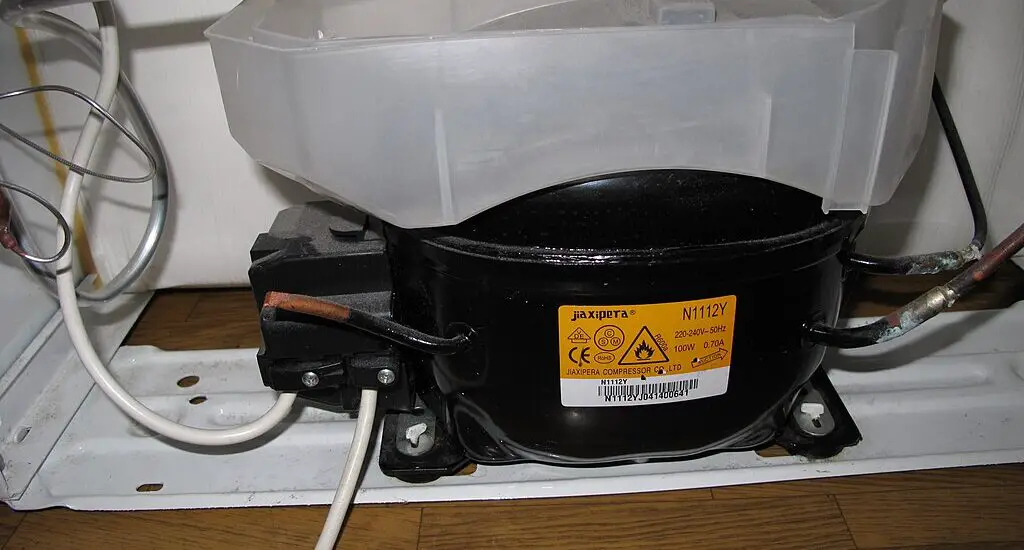This article will walk you through the steps to troubleshoot and resolve the ‘refrigerator compressor buzzing not cooling’ issue.

Understanding the ‘Refrigerator Compressor Buzzing Not Cooling’ Problem
The buzzing sound from a refrigerator usually indicates that the compressor—the part responsible for cooling—is active. However, if your refrigerator isn’t cooling despite the buzzing, it means that something is wrong. The compressor might be working but failing to cool due to various possible reasons such as a malfunctioning fan, dirty coils, or a defrost issue.
Steps to Resolve the ‘Refrigerator Compressor Buzzing Not Cooling’ Problem
Follow the steps below to resolve the “refrigerator compressor buzzing not cooling’ problem.
Step 1: Safety First
Before you do anything else, unplug the refrigerator from the electrical outlet. This step is crucial for avoiding any potential electrical shocks while you’re investigating or attempting repairs.
Step 2: Clean the Coils
The condenser coils are a vital component of your refrigerator’s cooling system. Over time, these coils can accumulate dust, dirt, and pet hair, making it difficult for them to release heat effectively.
Inefficiency in heat dissipation means the compressor has to work harder, which could be why it’s buzzing but not cooling. So, cleaning these coils is essential.
Locate the Coils: Generally, the coils are located either at the back of the refrigerator or beneath it. You may need to remove a back panel or a toe grille at the front bottom of the appliance to access them.
Unplug and Move the Refrigerator: Remember to unplug the appliance before starting. You might need to move your refrigerator away from the wall for better access.
Cleaning Tools: A coil brush specifically designed for this purpose is ideal, but you can also use the brush attachment of your vacuum cleaner. Avoid using any liquid cleaners as they may damage the coils.
You can use this Amazon-listed Vanitek Dryer Vent Cleaner Lint Brush for this task.
Clean the Coils: Gently brush the coils to remove the dust and debris. Be careful not to bend or damage the coils while cleaning. If using a vacuum, apply the brush gently to suck away the dirt.
Final Check: Once you’ve finished, plug the refrigerator back in briefly to make sure no electrical components are disturbed.
Step 3: Check for Frost Buildup
Frost accumulation can be another culprit when your refrigerator is buzzing but not cooling. This frost can block air vents, reducing airflow and making it harder for your appliance to maintain the desired temperature.
Inspect the Freezer: Open the freezer compartment and look at the walls and the evaporator coil area. Excessive frost buildup is easy to spot.
Manual Defrost: If you find frost, unplug the refrigerator, empty the freezer, and allow it to defrost by leaving the doors open. Place towels around the appliance to soak up any melted water.
Clean and Dry: Once the frost has melted, wipe down the interior surfaces to remove any remaining moisture.
Restart: Plug the refrigerator back in and monitor the temperature for the next 24 hours to see if the issue has been resolved.
Check out these other articles…
2-Stage Refrigeration Compressor: Your Comprehensive Guide
Refrigeration Compressor Capacity Control: Your Ultimate 411
Compressor Sweating: Your Complete Guide
Short Cycling of Refrigeration Compressor: Proven solutions
Refrigerator Compressor Always On: 4 Causes & Sure Fixes
Step 4: Inspect the Fans
Fans play a crucial role in your refrigerator’s cooling process. A malfunctioning fan can inhibit airflow, preventing the appliance from cooling properly.
Identify the Fans: Most refrigerators have at least two fans—an evaporator fan and a condenser fan. The evaporator fan is usually located in the freezer compartment, while the condenser fan is near the compressor and coils.
Listen and Observe: Plug the refrigerator back in briefly and listen for fan activity. If you don’t hear any sound or if it sounds irregular, that’s a clue something might be wrong.
Visual Inspection: For a better look, you may need to remove panels. The evaporator fan cover is usually inside the freezer, while the condenser fan is often accessible from the back or bottom of the refrigerator.
Test or Replace: If the fans are not working correctly, they may need to be replaced. This task might require specialized tools and expertise, so you may need to consult a professional for this step.
Step 5: Consult a Professional
If you’ve diligently followed steps 1 to 4 and the refrigerator is still not cooling, it’s time to consult a professional. Your appliance may require more specialized diagnostics, like checking the thermostat, the electronic control board, or the compressor itself for any failures. A qualified technician will have the tools and expertise to pinpoint and fix the issue.